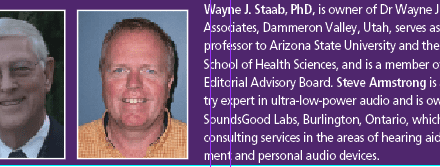Which stage are you in? Where do you want to take your practice?
“If you don’t know where you are going, any road will get you there.”
—Lewis Carroll
Author’s Note: This article looks at hearing care practice management based on ideas from the classic, “The Five Stages of Small Business Growth,” by Neil C. Churchill and Virginia L. Lewis that was published in the May-June 1983 issue of Harvard Business Review.1 The original article is still frequently quoted and referred to since its principles are as valid today as they were when it was first published.
Do you know what road your practice is taking? If you want it to arrive at success, it is not a good idea to assume that any road you take will lead you there. According to Churchill and Lewis, businesses can progress through five stages of evolution—stopping, or receding, or moving forward to adjacent stages:

Dom Spadaro is the Western divisional vicepresident of American Hearing Aid Associates (AHAA), providing business and marketing planning assistance and training for the staffs of AHAA network members located in the western United States. His office is in Seattle.
- Existence
- Survival
- Success
- Take-off
- Resource maturity
Each stage, in turn, is characterized along dimensions of management style, organization, extent of formal systems and processes, major strategies, and the relationship of the business and the business owner.
So, at what stage is your business? It is not “wrong” to be at Stage 1 instead of Stage 5. The key is to understand where you are and what you need to do to get to the next stage, if that’s your goal. Most important, you must not flounder and find yourself at an undesired stage.
Stage 1: Existence
When hearing care professionals open a dispensing practice, they demonstrate the willingness to become an entrepreneur and to assume risk. They know they will face challenges, and they are committed to making the practice a viable business.
Challenges. Among the challenges a start-up faces are attracting patients, delivering products, and providing services well enough for the business to become viable. As the practice grows, it must expand its patient base, generate cash, and have enough cash to cover the demands of the start-up phase.
Characteristics. In Stage 1, the owner is essentially the practice. They perform all the important tasks and provides the lion’s share of the time and energy to run the practice. Organization in Stage 1 is simple: only a few employees—perhaps even family members—do the administrative tasks. Minimal or no formal systems exist, and decisions are often made ad hoc. The major strategy and objective is to keep the business alive.
Failure Modes. The dangers of failure are greatest at this stage. The main risk is failure to attract enough customer acceptance to become viable. The result is that the owner is forced to close the practice when the start-up capital runs out. Selling at this stage generally means a loss.
Just about everyone overestimates sales and the timing of sales. They suffer from “sales hallucination” in their sales projections. Once the expenses outrun sales and the cash runs out, that’s it. The reason that 90% of small businesses fail is they are undercapitalized. Thus, realistic business plans are a crucial component of success in Stage 1.
Moving to Stage 2: Survival
“It is not the strongest of the species that survives, nor the most intelligent,” Charles Darwin was reported to say. “It is the one that is the most adaptable to change.”
Challenges. At this stage, the practice has demonstrated that it is a viable entity. One of the main challenges is maintaining capital assets, generating enough cash to break even, and to cover the repair and replacement of capital assets as they wear out (ie, revenue versus expense).
In Stage 2, cash flow remains crucial. The practice must be able to generate enough cash flow to stay in business and finance growth to a size that is sufficiently large—given your particular market niche—to earn an economic return on assets and labor.
Characteristics. In this stage, the management style is the same as in Stage 1: the owner still performs all or most of the important tasks. The practice also still has a minimal number of employees who are under the direct supervision of the owner. The extent of formal systems is minimal, and decision-making is basically ad hoc. The major strategy remains survival, and the owner is still essentially the practice.
Failure Modes. In survival stage, the practice is probably earning only marginal returns on invested time and capital. This can cause the owner to give up and exit, sometimes selling the practice at a slight loss or small gain.
Many practices never get past this stage. The owner manages to earn a living for as many as 20 to 30 years, but the practice never reaches its full potential.
Moving to Stage 3: Success
Challenges. At Stage 3, the practice is viable and has sufficient size and product market penetration to ensure average or above-average profits. The practice can stay at this stage indefinitely unless competitive market changes destroy its niche, or ineffective management erodes the practice’s competitive advantages.
The owner, then, is faced with a decision to exploit the accomplishments and expand the business, or to keep it stable and profitable—often providing an income base for the owner’s other activities.
Characteristics. In the success stage, the practice is large enough to have functional managers who relieve the owner of handling most or even all duties. Basic financial, marketing, and distribution systems exist, and planning in the form of operational budgets support functional delegation. The major strategy is to maintain the profit status quo, and the owner and practice managers monitor strategy to stay the course.
It is at this point that the owner must decide either to maintain the status quo or to grow. If growth is the choice, the owner marshals resources to grow through such means as increased marketing and sales and/or new offices and satellite locations. Managers must be on-board who will embrace this strategy, sometimes entering into partnerships or an exit plan for the owner.
Failure Modes. If the commitment to grow is weak or done weakly, the success stage may revert to maintaining the status quo. This may bring the practice back to the survival stage, which may produce an exit action or even bankruptcy. Thus, both success and maintaining the status quo, or success with a growth plan, involve risk.
The major strategies with the growth choice should be to put investment ahead of revenue by adding staff, such as audiologists, a director of operations, professional development representatives, telemarketers, and front office personnel. The owner must also look at adding locations, as well.
Moving to Stage 4: Take-off
Challenges. Perhaps the main challenge at this stage is how to grow rapidly and finance rapid growth. The practice must have the right people for the move, including a strong manager who has relieved the owner of day-to-day operating decisions. Management must be committed to continuing investment ahead of revenue and to determining when to add additional personnel.
Characteristics. The owner’s management style is now delegation of responsibility to others. The key managers must be competent to handle a growing and complex business. The practice is now divisionalized, and its formal systems are maturing. Strategic and operational planning is now performed with key managers.
At this point, the owner may still choose to sell the practice at a profit. But assuming the major strategy is to grow the practice, enough cash must be generated to satisfy the demands of growth.
Failure Modes. There are two big dangers at take-off stage: 1) growing too fast and 2) running out of cash. Another danger is that the owner is unable to delegate effectively enough to make the large practice run smoothly. This usually results in an unwanted forced exit or retrenching to a previous stage.
Moving to Stage 5: Resource Maturity
Challenges. The key challenge in this stage is to consolidate and control the financial gains due to rapid growth. Additionally, it behooves the practice to retain the advantages of its relatively small size and entrepreneurial spirit—including flexibility in the face of change. The challenge of when and how to expand the management staff also remains.
Characteristics. At this point, the management style has evolved to a hierarchy with professional managers and staff. The owner and the practice have become reasonably separate. The formal systems are extensive and sophisticated. The major strategy is to optimize return on investment.
Failure Modes. Dangers lurk at every stage, including this one. One of the main ones is “ossification” or business “old age.” This is marked by lack of innovative decision-making and the avoidance of risk. Standing still is a recipe for failure in today’s rapidly changing and competitive market, so growth must be continual, or the practice is exposed to the risk of folding, selling, merging, or retrenching to a previous stage.
Concluding Thoughts
As practices proceed through the various stages, their owners must continually be evaluating their personal and business goals, their own managerial and operational abilities (such as sales and marketing), their strengths and weaknesses, and likes and dislikes. Are they truly willing to delegate? Do they have the ability to look beyond the present and match the strengths and weaknesses of the practice to their goals?
Owners must also honestly evaluate their practice’s financial resources, including available cash and borrowing power. Does the practice have the depth and quality of management and staff to succeed and grow? Are the systems resources adequate and efficient enough to provide the information needed to plan and track results and opportunities and to plan future direction? If it is a member of a network like American Hearing Aid Associates, the practice can take advantage of available tools, resources, and guidance.
In the end, market share, customer relations, vendor relations, technical expertise, reputation, and the distribution process give a practice its position in its market and in the industry. If an owner has managed the stages correctly, they can enjoy much success and look forward to a very prosperous ending to a productive career in the hearing care profession.
Correspondence can be addressed to HR or Dom Spadaro at .
Reference
- Churchill NC, Lewis VL. The five stages of small business growth. Harvard Business Review. 1983. Available at: www.tameer.org.pk/images/The_Five_Stages_Of_Small_Business_Growth.pdf. Accessed January 29, 2012.
Citation for this article:
Spadaro D. The Evolution of a Small Business Hearing Review. 2012;19(03):48-51.





